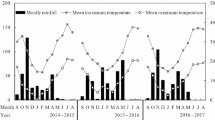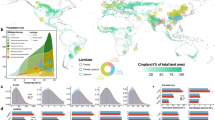Abstract
Improving fallow quality in upland rice-fallow rotations in West Africa through the site-specific use of leguminous cover crops has been shown to sustain the productivity of such systems. We studied the effects of a range of residue management practices (removal, burning, mulching and incorporation) on fallow biomass and N accumulation, on weed biomass and yield response of upland rice and on changes in soil physical and chemical characteristics in 2-year field trials conducted in three agroecological zones of Côte d'Ivoire. Across fallow management treatments and agroecological zones, rice yields were on average 20–30% higher in legume than in natural fallow plots. Weed biomass was highest in the savanna zone and lowest in the bimodal forest and tended to be less following a legume fallow. Regardless of the type of fallow vegetation and agroecological zone, biomass removal resulted in the lowest rice yields that varied from 0.5 t ha–1 in the derived savanna zone to 1.5 t ha–1 in the Guinea savanna zone. Burning of the fallow vegetation significantly increased yield over residue removal in the derived savanna (0.27 t ha–1, P<0.05) and bimodal forest zones (0.27 t ha–1, P<0.01), but not in the Guinea savanna. In both savanna environments, residue incorporation was superior to the farmers' practice of residue removal and rice yield increases were related to amounts of fallow N returned to the soil (r 2=0.803, P<0.01). In the forest zone, the farmers' practice of residue burning produced the highest yield (1.43 t ha-1 in the case of legumes) and resulted in the lowest weed biomass (0.02 t ha–1). Regardless of the site, improving the quality of the fallow or of its management had no significant effects on either soil physical or soil chemical characteristics after two fallow cycles. We conclude that incorporation of legume residues is a desirable practice for rice-based fallow rotation systems in savanna environments. No promising residue management alternatives to slash-and-burn were apparent for the forest zone. Determining the possible effects on soil productivity will require longer-term experiments.
Similar content being viewed by others
Author information
Authors and Affiliations
Additional information
Received: 21 October 1999
Rights and permissions
About this article
Cite this article
Akanvou, R., Becker, M., Chano, M. et al. Fallow residue management effects on upland rice in three agroecological zones of West Africa. Biol Fertil Soils 31, 501–507 (2000). https://doi.org/10.1007/s003740000199
Issue Date:
DOI: https://doi.org/10.1007/s003740000199




